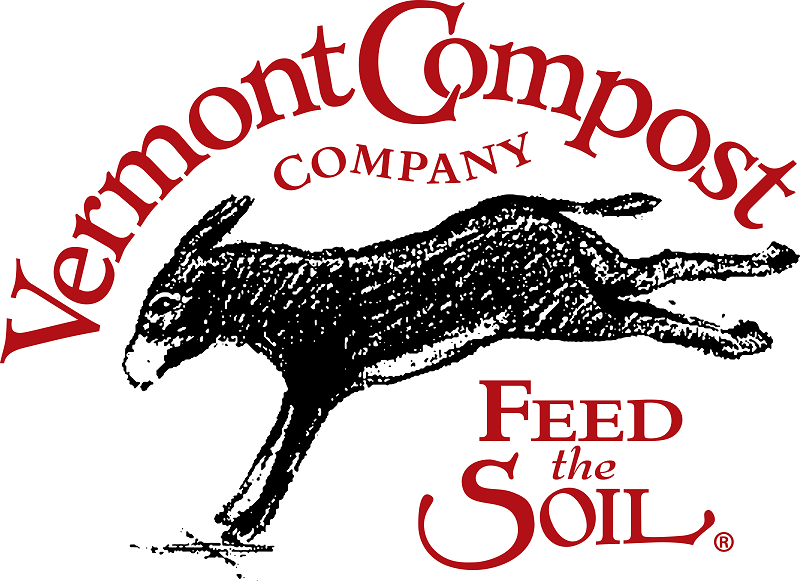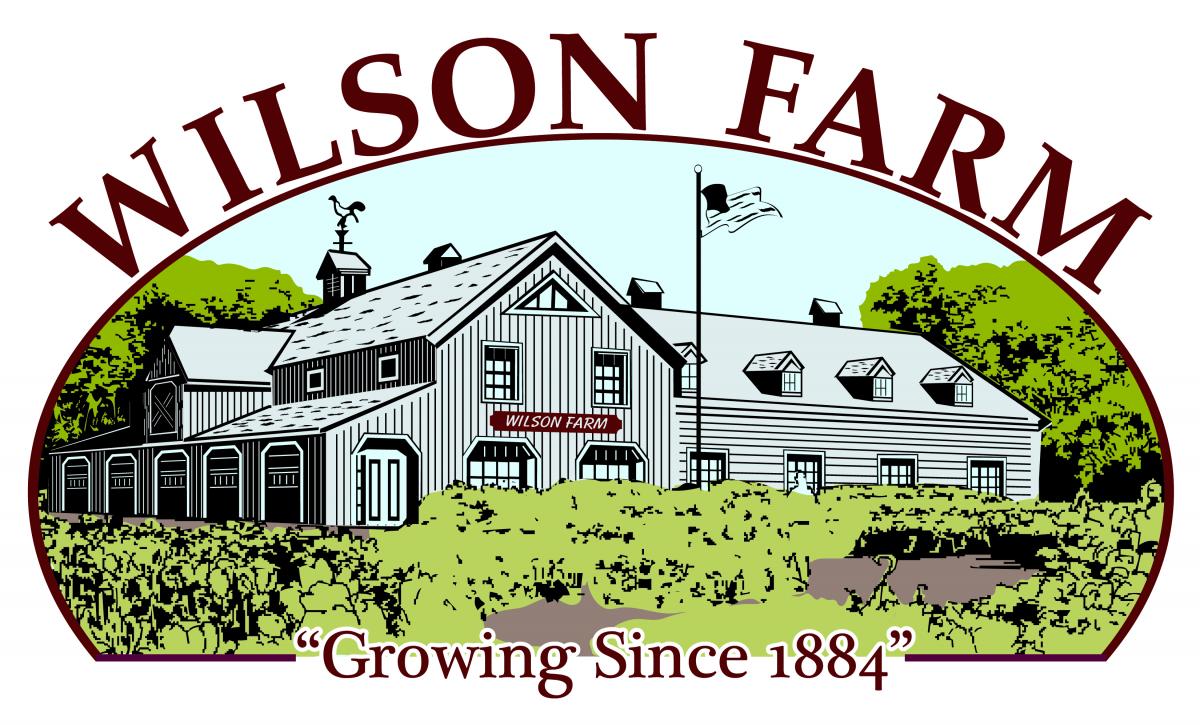To print this issue, either press CTRL/CMD + P or right click on the page and choose Print from the pop-up menu.
Click on images to enlarge.

Crop Conditions
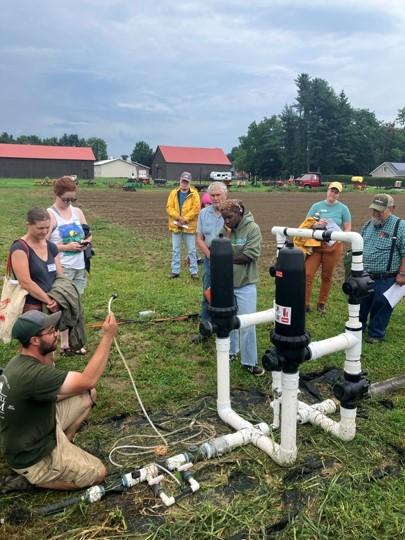 Onions are mostly curing now, as growers rushed to get them out of the field before Hurricane Debby dumped (or threatened to dump) big rains across the state this week. Storms and rain also threatened our climate change-themed Twilight Meeting last week at Bardwell Farm, but we had a good crowd turnout in the end—thanks to those who came! Harrison shared his experience getting his feet wet (pun intended) using soil moisture sensors. He bought an automated irrigation system with financial assistance from NRCS, but struggled to get it setup in time to use this season. He found that installing just 2 soil moisture sensors in each high tunnel (at the top and bottom of the crop rooting zone) and using the handheld reader to check them each week provided plenty of data to help him fine-tune his irrigation scheduling. This was critical for him because the soil in the tunnels is infested with Phytophthora capsici, and by limiting the amount of water in the soil, he is able to grow a forest of multi-colored bell peppers despite having this disease present.
Onions are mostly curing now, as growers rushed to get them out of the field before Hurricane Debby dumped (or threatened to dump) big rains across the state this week. Storms and rain also threatened our climate change-themed Twilight Meeting last week at Bardwell Farm, but we had a good crowd turnout in the end—thanks to those who came! Harrison shared his experience getting his feet wet (pun intended) using soil moisture sensors. He bought an automated irrigation system with financial assistance from NRCS, but struggled to get it setup in time to use this season. He found that installing just 2 soil moisture sensors in each high tunnel (at the top and bottom of the crop rooting zone) and using the handheld reader to check them each week provided plenty of data to help him fine-tune his irrigation scheduling. This was critical for him because the soil in the tunnels is infested with Phytophthora capsici, and by limiting the amount of water in the soil, he is able to grow a forest of multi-colored bell peppers despite having this disease present.
Our next meeting is next Tuesday, August 13, at the UMass Crop and Animal Research Farm where the Vegetable Team and colleagues from around UMass will share their ongoing field research with the public. This year our team will have cucumber, basil, and lettuce variety trials to showcase, and we’ll also discuss corn earworm population dynamics. And it’s always fun to see what is happening across the different research labs at the University! One other note about events: our sunflower meeting at Siena Farm later this month is canceled, but we are replacing it with a workshop on dahlias later this fall. We hope to have the details out by next week—keep an eye out!
Brassicas
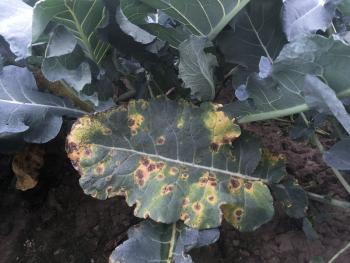 Alternaria leaf spot is developing in brassica plantings, right on schedule with the wet weather we've been having. Alternaria causes round lesions that are initially small but can coalesce into large blighted areas of the foliage. Lesions are surrounded by a yellow halo and will form concentric rings as the disease progresses. Black sporulation will develop under humid conditions. Disease starts on lower leaves and moves upward as it progresses. The fungus overwinters on crop residues in the soil, and splashes up from the soil during irrigation or rain events to infect new plants. Spores spread from field to field via wind. Tilling under crop residues promptly and thoroughly after harvest can help reduce the amount of inoculum. Avoid working in fields when foliage is wet, and if you have a field that does not yet have Alternaria, work in that field first, before working in infected fields, to slow the spread of the disease. Fungicides can control Alternaria but must be applied preventatively. See the appropriate crop disease control section of the New England Vegetable Management Guide for labeled materials.
Alternaria leaf spot is developing in brassica plantings, right on schedule with the wet weather we've been having. Alternaria causes round lesions that are initially small but can coalesce into large blighted areas of the foliage. Lesions are surrounded by a yellow halo and will form concentric rings as the disease progresses. Black sporulation will develop under humid conditions. Disease starts on lower leaves and moves upward as it progresses. The fungus overwinters on crop residues in the soil, and splashes up from the soil during irrigation or rain events to infect new plants. Spores spread from field to field via wind. Tilling under crop residues promptly and thoroughly after harvest can help reduce the amount of inoculum. Avoid working in fields when foliage is wet, and if you have a field that does not yet have Alternaria, work in that field first, before working in infected fields, to slow the spread of the disease. Fungicides can control Alternaria but must be applied preventatively. See the appropriate crop disease control section of the New England Vegetable Management Guide for labeled materials.
Cucurbits
 Cucurbit downy mildew (CDM) was confirmed in cantaloupe this week in our sentinel plot in Franklin Co. We confirmed CDM on cucumber last week. There are 2 strains of CDM, with one most likely to infect cucumber and cantaloupe, and the other most likely to infect watermelon, pumpkins, and winter and summer squashes. We most often see the strain that infects cucumber and cantaloupe in the Northeast. CDM on other cucurbit hosts has not been reported north of Virginia (pumpkin) and South Carolina (watermelon). Growers should now be regularly applying both broad-spectrum and DM-targeted fungicides to cucumber and cantaloupe. Rotate between at least 2 targeted materials for resistance management. Organic growers can apply copper preventatively. For the current cucurbit spray recommendations see this article from earlier this year. There are DM-resistant cucumber varieties available (e.g. Chaperon, Citadel, Espirit, SV4142, Bristol, NY264, and DMR401) that provide good control for several weeks after the disease has arrived.
Cucurbit downy mildew (CDM) was confirmed in cantaloupe this week in our sentinel plot in Franklin Co. We confirmed CDM on cucumber last week. There are 2 strains of CDM, with one most likely to infect cucumber and cantaloupe, and the other most likely to infect watermelon, pumpkins, and winter and summer squashes. We most often see the strain that infects cucumber and cantaloupe in the Northeast. CDM on other cucurbit hosts has not been reported north of Virginia (pumpkin) and South Carolina (watermelon). Growers should now be regularly applying both broad-spectrum and DM-targeted fungicides to cucumber and cantaloupe. Rotate between at least 2 targeted materials for resistance management. Organic growers can apply copper preventatively. For the current cucurbit spray recommendations see this article from earlier this year. There are DM-resistant cucumber varieties available (e.g. Chaperon, Citadel, Espirit, SV4142, Bristol, NY264, and DMR401) that provide good control for several weeks after the disease has arrived.
 Squash vine borer (SVB) damage is becoming more apparent in infested crops now, as larvae develop and tunnel up into stems. SVB affects only thick-stemmed cucurbits (e.g. summer squash, zucchini, giant pumpkin, acorn squash). If plants are wilting and/or foliage is turning yellow, check the base of the plant for a hole, accompanied by lots of sawdust-like frass. Frass may have been washed away by rain, and entry holes can lead to bacterial rots. Slice longitudinally up stems that show entry holes, looking for a 1”-long, cream-colored larva. There is no effective treatment for infested plants at this point. The adult flight is over, so unaffected plants are not likely to be at risk.
Squash vine borer (SVB) damage is becoming more apparent in infested crops now, as larvae develop and tunnel up into stems. SVB affects only thick-stemmed cucurbits (e.g. summer squash, zucchini, giant pumpkin, acorn squash). If plants are wilting and/or foliage is turning yellow, check the base of the plant for a hole, accompanied by lots of sawdust-like frass. Frass may have been washed away by rain, and entry holes can lead to bacterial rots. Slice longitudinally up stems that show entry holes, looking for a 1”-long, cream-colored larva. There is no effective treatment for infested plants at this point. The adult flight is over, so unaffected plants are not likely to be at risk.
|
table 1. Squash Vine borer Pheromone Trap captures for week ending August 7
|
|
|---|---|
|
Trap location
|
SVB
|
|
Whately
|
0 |
| Lexington | 0 |
|
North Easton
|
2 |
|
Sharon
|
1 |
|
Westhampton
|
0 |
|
Spray thresholds: Thick-stemmed cucurbits only. 5 moths/week for bush-type cucurbits. 12 moths/week for vining cucurbits.
|
|
Nightshades
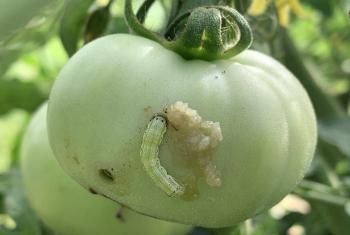 Tomato fruitworm (aka corn earworm) was observed tunneling into high tunnel tomatoes in Hampshire Co. this week. This pest, which primarily feeds in corn, will also attack tomatoes, particularly if moth numbers are high and fresh corn silk is scarce. Small larvae enter the stem end of fruit and develop inside, emerging later and much larger from the fruit wall. If control is warranted, use selective insecticides, such as Bt (e.g., Xentari Dipel) to avoid disrupting natural enemies that control secondary pests, such as mites and aphids. Timing of applications is key since larvae are protected once they enter the fruit.
Tomato fruitworm (aka corn earworm) was observed tunneling into high tunnel tomatoes in Hampshire Co. this week. This pest, which primarily feeds in corn, will also attack tomatoes, particularly if moth numbers are high and fresh corn silk is scarce. Small larvae enter the stem end of fruit and develop inside, emerging later and much larger from the fruit wall. If control is warranted, use selective insecticides, such as Bt (e.g., Xentari Dipel) to avoid disrupting natural enemies that control secondary pests, such as mites and aphids. Timing of applications is key since larvae are protected once they enter the fruit.
 Anthracnose was observed in a field in Hampshire Co. this week. Anthracnose is a fungal disease that causes round, sunken lesions on tomato and pepper fruit. The lesions eventually develop concentric rings of dark fungal fruiting bodies, giving them a fuzzy black appearance. This disease affects ripe fruit only, and we most commonly see it in crops that are being underharvested. Harvest thoroughly to reduce inoculum, then practice at least a 1-year crop rotation out of solanaceous crops. This fungus can be carried on seed—hot water seed treatment can effectively eliminate the pathogen from the seed.
Anthracnose was observed in a field in Hampshire Co. this week. Anthracnose is a fungal disease that causes round, sunken lesions on tomato and pepper fruit. The lesions eventually develop concentric rings of dark fungal fruiting bodies, giving them a fuzzy black appearance. This disease affects ripe fruit only, and we most commonly see it in crops that are being underharvested. Harvest thoroughly to reduce inoculum, then practice at least a 1-year crop rotation out of solanaceous crops. This fungus can be carried on seed—hot water seed treatment can effectively eliminate the pathogen from the seed.
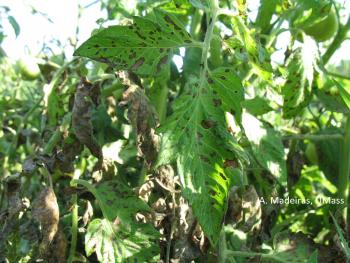 Stemphylium leaf spot, or gray leaf spot, was confirmed last week on tomato and another case is suspected this week. This is a relatively new fungal disease of tomato in the Northeast. The pathogen forms brown leaf spots that develop a gray appearance when the fungus produces spores. It can look very similar to Septoria leaf spot. See the article in this issue and the Tomato Disease Control section of the New England Vegetable Management Guide for more information.
Stemphylium leaf spot, or gray leaf spot, was confirmed last week on tomato and another case is suspected this week. This is a relatively new fungal disease of tomato in the Northeast. The pathogen forms brown leaf spots that develop a gray appearance when the fungus produces spores. It can look very similar to Septoria leaf spot. See the article in this issue and the Tomato Disease Control section of the New England Vegetable Management Guide for more information.
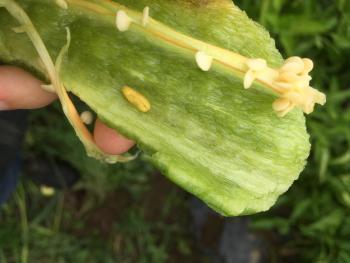 Pepper maggot is causing damage now in pepper crops. Pepper maggot feeding damage often leads to secondary rots, and infested fruit are often culled in the field or packhouse without growers knowing the cause of the damage. Open up rotting fruit, or fruit that fills with water during washing, and look for 1 cm-long larvae inside. Remove infested fruit from the field and destroy (make sure the fruit isn’t left in a cull pile for the pest to complete its life cycle). Growing on black plastic and covering aisles with landscape fabric can break the pepper maggot life cycle—the maggots will drop to the soil to pupate but will die if they are prevented by the landscape fabric from entering the soil. Pepper maggot can be effectively managed using insecticides, but they must be applied at the first sign of pest presence.
Pepper maggot is causing damage now in pepper crops. Pepper maggot feeding damage often leads to secondary rots, and infested fruit are often culled in the field or packhouse without growers knowing the cause of the damage. Open up rotting fruit, or fruit that fills with water during washing, and look for 1 cm-long larvae inside. Remove infested fruit from the field and destroy (make sure the fruit isn’t left in a cull pile for the pest to complete its life cycle). Growing on black plastic and covering aisles with landscape fabric can break the pepper maggot life cycle—the maggots will drop to the soil to pupate but will die if they are prevented by the landscape fabric from entering the soil. Pepper maggot can be effectively managed using insecticides, but they must be applied at the first sign of pest presence.
Sweet corn
European corn borer (ECB): Trap counts are low, and second generation ECB caterpillars are causing feeding damage in crops now. This generation feeds on sweet corn but also a wide range of other crops, from peppers to garlic. ECB damage was suspected this week in dahlias—stems and leaves were turning brown and dying back, and slicing open them stems revealed insect tunneling.
Corn earworm trap counts are still relatively high, with most farms on a 4-day spray schedule but a few on a 3-day schedule. Corn earworm (also called tomato fruitworm) will also feed on tomato fruit, so if trap counts are high in your area, it's worth scouting your tomatoes for damage too, and spraying if necessary.
Fall armyworm (FAW) continues to be caught in low numbers in some locations, with 4 out of 15 trapping locations reporting moths this week. Caterpillars are actively feeding in the latest corn plantings now, which are at whorl stage. A good time to apply a pesticide is when tassels have just fully emerged, to catch the caterpillars before they migrate down from the whorl and tassels into the ears.
| Table 2. GDDs & Sweet corn pest trap captures for week ending August 7 | |||||||
|---|---|---|---|---|---|---|---|
| Nearest Weather station |
GDD (Base 50°F) |
Trap Location | ECB NY | ECB IA | FAW | CEW | CEW SPRay interval* |
| Western MA | |||||||
| North Adams | 1875 | n/a | n/a | n/a | n/a | n/a | n/a |
| Richmond | 1697 | n/a | n/a | n/a | n/a | n/a | n/a |
| South Deerfield | 2027 | Whately | 4 | 1 | 7 | 52.5 | 4 days |
| Easthampton | 1951 | Northampton | n/a | n/a | n/a | 12 | 4 days |
| Chicopee Falls | 2072 | Granby | 0 | 0 | 0 | 14 | 4 days |
| Granville | 1780 | Southwick | 0 | 0 | 0 | 20 | 4 days |
| Central MA | |||||||
| Leominster | 1875 | Leominster | - | - | - | - | - |
| Lancaster | - | - | - | - | - | ||
| Northbridge | 1894 | Grafton | 2 | 0 | 0 | 22 | 4 days |
| Worcester | 1892 | Spencer | 0 | 0 | 0 | 22 | 4 days |
| Eastern MA | |||||||
| Bolton | 1910 | Bolton | 0 | 0 | 0 | 12 | 4 days |
| Stow | 1925 | Concord | 6 | 0 | 1 | 27 | 4 days |
| Lawrence | 1953 | Haverhill | 0 | 0 | 0 | 33 | 4 days |
| Ipswich | 1916 | Ipswich | 2 | 0 | 0 | 13 | 4 days |
| Harvard | 1941 | Littleton | 11 | 0 | 0 | 22 | 4 days |
| - | - | Millis | 0 | 0 | n/a | - | - |
| Sharon | 1868 | North Easton | 0 | 0 | 0 | 218 | 3 days |
| Sharon | 4 | 0 | n/a | - | - | ||
| - | - | Sherborn | 3 | 0 | 0 | 30 | 4 days |
| Providence, RI | 1930 | Seekonk | 0 | 0 | 6 | 120 | 3 days |
| Swansea | 15 | 0 | 2 | 27 | 4 days | ||
|
ND - no GDD data for this location - no numbers reported for this trap n/a - this site does not trap for this pest * If 2+ days above 80°F occur, shorten spray interval by 1 day. ** If CEW trap captures are below 1.4 moths/week, scout block for ECB and FAW caterpillars and make a pesticide application if 12% of plants in a 50-plant sample are infested. |
|||||||
| Table 3. corn earworm spray intervals | ||
|---|---|---|
| Moths/Night | Moths/Week | Spray Interval |
| 0 - 0.2 | 0 - 1.4 | no spray |
| 0.2 - 0.5 | 1.4 - 3.5 | 6 days |
| 0.5 - 1 | 3.5 - 7 | 5 days |
| 1 - 13 | 7 - 91 | 4 days |
| Over 13 | Over 91 | 3 days |
Contact Us
Contact the UMass Extension Vegetable Program with your farm-related questions, any time of the year. We always do our best to respond to all inquiries.
Vegetable Program: 413-577-3976, umassveg@umass.edu
Staff Directory: https://ag.umass.edu/vegetable/faculty-staff
Home Gardeners: Please contact the UMass GreenInfo Help Line with home gardening and homesteading questions, at greeninfo@umext.umass.edu.
Harvest and Curing Tips for Onions
Lots of farms are done harvesting onions already, ahead of the rain expected from Hurricane Debby, so greenhouses and barns are filling up with tables and crates of curing onions. Deciding when and how to harvest onions, then where and how to cure them can be challenging. When are they really ready to be pulled? Is the weather too wet or hot, or is the field too weedy to field cure? What should I do if there is a lot of foliar disease in my crop? The recent cool August temperatures are closer to ideal than normal for curing, but the upcoming rain will make the curing environment more humid and will prevent field curing. Here are a few tips, originally from University of Minnesota Extension:
Harvest
 In order to maximize storage life, onions need to be harvested while the onion foliage is still partially (30-40%) erect, which is unfortunately long before maximum yield is attained (when tops are completely down and dry). Yields may increase 30-40% between the stage when tops begin to go down and when the leaves are fully down and dry, so it is tempting to leave onions in the field as long as possible. The optimum time for harvest, therefore, must be a balance between highest yields and reduced bulb storage quality. From UGA Extension: “Maturity is best determined by pinching the neck of the growing onion. Necks of immature onions are stiff, while necks of optimally mature onions are soft and limber. When the necks are so weak that they cannot support the tops, the onions are over-mature. Simply observing the percentage of tops having fallen over is not a true indication of maturity, since the tops can be knocked over by strong winds, rain or become limp from lack of moisture.”
In order to maximize storage life, onions need to be harvested while the onion foliage is still partially (30-40%) erect, which is unfortunately long before maximum yield is attained (when tops are completely down and dry). Yields may increase 30-40% between the stage when tops begin to go down and when the leaves are fully down and dry, so it is tempting to leave onions in the field as long as possible. The optimum time for harvest, therefore, must be a balance between highest yields and reduced bulb storage quality. From UGA Extension: “Maturity is best determined by pinching the neck of the growing onion. Necks of immature onions are stiff, while necks of optimally mature onions are soft and limber. When the necks are so weak that they cannot support the tops, the onions are over-mature. Simply observing the percentage of tops having fallen over is not a true indication of maturity, since the tops can be knocked over by strong winds, rain or become limp from lack of moisture.”
Digging and windrowing
To facilitate curing onions for harvest and storage, onion rows are undercut and lifted and, if the onions will be cured in the field, they are windrowed. Rod-weeder diggers and knife undercutters are most often used. Onions are commonly dug and windrowed with tops on – tops can be layered on top of bulbs to protect the bulbs from sunscald. After field drying has occurred, the onions may be topped and placed in storage buildings or moved to a curing space to continue drying down.
Curing
The goals of curing onions are to properly dry down the outer bulb layers to protect the onion bulb and to dry down and seal any wounds that may have occurred during harvest. Onions can be cured in the field, in open sheds, or by artificial means before or in storage. Adequate curing in open sheds may require 2 to 4 weeks, depending on the weather, with faster curing occurring in hotter, dryer weather. Optimal curing conditions, which also result in the best skin color, are 75-80°F and 70-80% relative humidity, with good air circulation. Onions are considered fully cured when the neck is tight and the outer scales are dry and make a rustling sound when handled. When you pinch the neck between your fingers, it should feel dry and not juicy and slippery. This condition is reached when onions have lost 3-5% of their weight. If not adequately cured, onions are likely to decay in storage. The most common form of decay is Botrytis neck rot, which occurs at the top (or “neck”) of the bulb.
Topping
Most onions are cured with tops on and topped before being moved to storage. Remove tops when they are totally dry, or, only remove the dry portion. Cutting through any portion of the top while it is still green or moist allows for entry of bacteria and fungi and most commonly can result in excessive Botrytis neck rot in storage. When all or a portion of the onion top is left on, the remaining tops are removed during grading and packing. Topping is either done by hand or with mechanical roller toppers.
Here are our low-tech recommendations for curing and storage in New England: A greenhouse or hoophouse provides a good environment for curing, where temperature, airflow, and moisture can be somewhat controlled. Be sure to keep the temperature in the house below 85°F, which will probably require turning on fans and/or leaving sides and doors wide open. Consider using shade cloth over the house to help moderate temperature. Curing can be done in the field, but it is harder to achieve good conditions for curing in an uncontrolled field setting. Avoid field curing onions if rain is forecasted and, if it does rain, let the onions dry fully before handling. Handling bulbs when they are wet can facilitate the spread of fungal and bacterial diseases that can further develop in storage. Weedy fields may be excessively moist and air circulation may be limited; these conditions are not suitable for curing, so bring onions inside to cure. Temperature and sun are also factors to consider—sunshine and temperatures in the 80s will enhance the bronze color in the skins, but extremely hot sun and temperatures in the 90s can cause sunscald. Onions curing on a sandy soil will heat up more quickly than those curing on a heavier soil.
Storage
 To ensure maximum storage life, onions must be promptly stored after curing. Get them out of the sun, as exposure to light after curing will induce greening of the outer scales. The optimum temperature for long-term storage of onions is 32°F with 65-70% relative humidity, but it is important to bring them down to this temperature slowly. In fact, holding onions in a barn or garage so that they cool along with the average outdoor temperature in late summer and fall works quite well. Avoid cooling bulbs to well-below the average daily temperature because they will draw moisture from the warmer air, which can lead to disease development. If you are selling the onions within a couple of months, keeping them in an un-insulated barn is fine. An insulated storage room is needed for longer-term storage.
To ensure maximum storage life, onions must be promptly stored after curing. Get them out of the sun, as exposure to light after curing will induce greening of the outer scales. The optimum temperature for long-term storage of onions is 32°F with 65-70% relative humidity, but it is important to bring them down to this temperature slowly. In fact, holding onions in a barn or garage so that they cool along with the average outdoor temperature in late summer and fall works quite well. Avoid cooling bulbs to well-below the average daily temperature because they will draw moisture from the warmer air, which can lead to disease development. If you are selling the onions within a couple of months, keeping them in an un-insulated barn is fine. An insulated storage room is needed for longer-term storage.
Quick Tips for Best Quality
- Be sure onions are well-dried and necks are tight (i.e. the tissue does not slide when you roll the neck between your fingers) before topping. Bacterial diseases and Botrytis neck rot can move through green tissue into the bulbs. These diseases do not move through dry tissue.
- Leave 2-3 inches of neck on the bulb. This increases the distance from the cut surface to the bulb for these pathogens to travel.
- Minimize mechanical injury during harvest & topping. Reduce drops to 6” and pad sharp surfaces. Bruises provide direct entry points for diseases to get started.
- Grade out damaged onions before putting them into storage. Damaged bulbs give off moisture, which is favorable for development of diseases in storage.
--Written by the UMass Vegetable Program
Gray Leaf Spot on Tomato

 Gray leaf spot of tomato has become more common in the Northeast in the last several years. This disease is caused by several species of the fungus Stemphylium. Stemphylium lycopersici (= S. floridanum), S. solani, and S. botryosum (AKA Macrosporium commune), have all been reported to cause the disease on tomatoes in North America. These species do not cause Stemphylium leaf blight of onion, which is associated with the species S. vesicarium.
Gray leaf spot of tomato has become more common in the Northeast in the last several years. This disease is caused by several species of the fungus Stemphylium. Stemphylium lycopersici (= S. floridanum), S. solani, and S. botryosum (AKA Macrosporium commune), have all been reported to cause the disease on tomatoes in North America. These species do not cause Stemphylium leaf blight of onion, which is associated with the species S. vesicarium.
Symptoms begin as small brown lesions that may or may not have a yellow halo. Lesions may turn tan as they enlarge and may tear in the center or appear gray due to sporulation of the fungus. Lower leaves are often affected first. Severely affected leaves may turn yellow or brown and defoliate. Symptoms are seldom seen on petioles or stems, and fruit is not affected. The symptoms closely resemble those of Septoria leaf spot, but Septoria lesions are often observed on stems and petioles.
Stemphylium species survive in infected crop debris and solanaceous weeds. They may also be seedborne. The spores are spread by wind and splashing water. The optimum temperature for spore germination and disease development is 75-80°F. Symptoms can appear as soon as 5 days after infection.
Gray leaf spot management options include proper plant spacing and removal of lower leaves to increase air circulation. Avoid overhead watering if possible. Control weeds and remove volunteer solanaceous plants from fields. Remove or plow under infected crop debris and rotate away from solanaceous crops for at least 3 years. Several resistant varieties are available: see https://www.vegetables.cornell.edu/pest-management/disease-factsheets/disease-resistant-vegetable-varieties/ for a complete list.
Fungicides labeled for gray leaf spot management include chlorothalonil (Bravo), mancozeb and zoxamide (Gavel), cyprodinil and difenoconazole (Inspire Super), trifloxystrobin and fluopyram (Luna Sensation), azoxystrobin and benzovindiflupyr (Mural), and copper (Nu-Cop), among others. Fungicide resistance has been observed, so be sure to rotate active ingredients.
--Written by Angie Madeiras, UMass Plant Diagnostician
News
EPA Issues Emergency Order to Stop Use of Pesticide Dacthal to Address Serious Health Risk
*You can no longer use Dacthal on your farms.*
On August 6, the EPA issued an emergency order to stop the use of dimethyl tetrachloroterephthalate (also known as DCPA and by its trade name, Dacthal), which was previously labelled in brassicas, cucurbits, onions, radishes, sweet potatoes, and tomatoes. The emergency order was made because the EPA determined that when a pregnant individual is exposed to Dacthal, the fetus can experience changes to their thyroid hormone levels that are linked to low birth weight, impaired brain development, decreased IQ, and impaired motor skills. These effects may be irreversible. The registrant attempted to develop safe use patterns, but the EPA determined that there was no practical way to reduce exposure to levels that would be safe for fetuses. This product has been useful for preemergent weed control, especially for specialty brassica growers who have few other options. However, now that we understand these harmful effects of this product, all sale, distribution, and use must stop immediately. See the full Emergency Order here or here.
This affects Dacthal Flowable Herbicide, Dacthal W-75 Herbicide, and Technical Chlorthal Dimethyl – all of which are no longer legal to use, distribute, or sell.
Events
2024 UMass Crop & Animal Research Farm Tour - South Deerfield, MA
When: August 13, 2024, 3:30pm to 5:30pm
Where: UMass Crop & Livestock Research & Education Farm, 89 River Rd., South Deerfield, MA
Registration: Free. Click here to register.
Join UMass Extension and the UMass College of Natural Sciences and Stockbridge School of Agriculture for the 2024 Crop & Animal Research Farm Tour! We will take a tour of the research farm and hear about ongoing research, then have pizza and plenty of time for discussion afterwards.
Research and projects presented will include:
- Student Farm Enterprise
- How native plant species used in pollinator habitats affect disease transmission in pollinators
- Exploring the benefits of living mulch for corn silage systems
- Vegetable variety trials for disease resistance and heat tolerance, including cucumbers, basil, and lettuce
- Corn earworm genetics
- Potato leafhopper control in potatoes
- Corn and sorghum intercropping reduces nitrogen loss and greenhouse gas emissions
- Genes and genetics in agriculture
Bees and Beyond: Pollinators at the Arboretum
When:Saturday, August 18, 2:00-3:30pm
Where: Arnold Arboretum, 125 Arborway, Boston, MA 02130
Registration: Free. Registration is required. Click here to register.
Join pollinator expert and UMass Extension educator Nicole Bell for a walk through the Arboretum’s meadows to find bees and other pollinators in their natural habitat. Nicole will use a sweep net to find and catch bees in the landscape so participants can see them up close, while we talk about the most common bees found in Massachusetts, where they live and what they eat, and the importance of places like the Arboretum for pollinator conservation.
Field Walk at Siena Farms - CANCELED ❌
We have unfortunately had to cancel this twilight meeting. Keep an eye out for another cut flower meeting coming up this fall!
Twilight Meeting: Climate Impacts on Weed Management and Soil Health - South Deerfield, MA
When: Tuesday, October 8, 2024, 4-6pm, with a light supper to follow
Where: UMass Crop & Livestock Research & Education Farm, 89 River Rd., South Deerfield, MA, 01373
Registration: Free! Please register in advance so we can order enough food. Click here to register.
How are climate change and hotter temperatures affecting our soils? Often, practices like reducing tillage and cover cropping are recommended to improve soil health, reduce risk of topsoil loss and enhance resilience to drought and flood—practices that can also affect weed management. UMass Extension will discuss general impacts of climate change on soil health and highlight current research on updating recommendations for planting timing and overwintering survival of cover crop species in MA. Maria Gannett, UMass Extension Weeds Specialist, will relate these strategies to how they can impact weed management.
1 pesticide recertification credit is available for this program.
This event is co-sponsored by CISA as part of their Adapting your Farm to Climate Change Series.
Save the Date! Gaining Ground Farm Tour
When: Thursday, October 17, 2024, 4-6pm
Where: Gaining Ground, 341 Virginia Rd., Concord, MA 01742
Join New Entry and UMass Extension for a farm tour of Gaining Ground Farm in Concord, MA!
Registration and event details coming soon.
Vegetable Notes. Maria Gannett, Genevieve Higgins, Lisa McKeag, Susan Scheufele, Alireza Shokoohi, Hannah Whitehead, co-editors. All photos in this publication are credited to the UMass Extension Vegetable Program unless otherwise noted.
Where trade names or commercial products are used, no company or product endorsement is implied or intended. Always read the label before using any pesticide. The label is the legal document for product use. Disregard any information in this newsletter if it is in conflict with the label.
The University of Massachusetts Extension is an equal opportunity provider and employer, United States Department of Agriculture cooperating. Contact your local Extension office for information on disability accommodations. Contact the State Center Directors Office if you have concerns related to discrimination, 413-545-4800.



